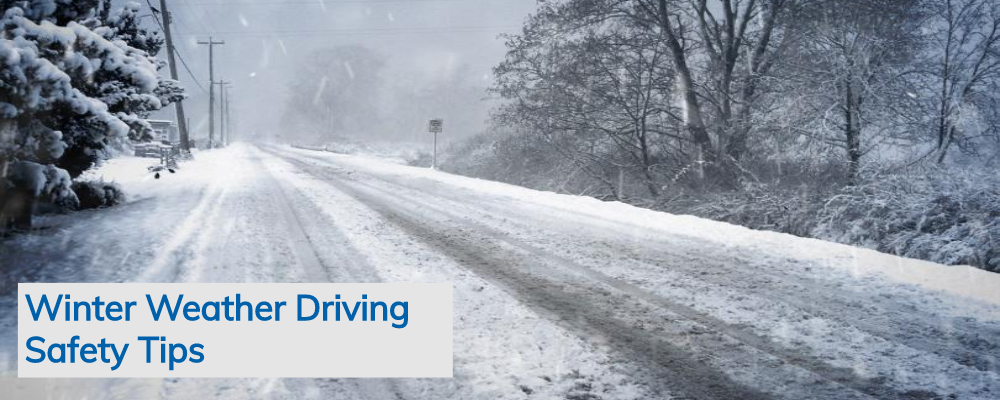Winter Driving Safety Tips
12/23/2019
Category : General Safety

Winter presents drivers – and travelers – with many hazards. Snow, ice, black ice, fog, and heavy rain can wreak havoc on the roads and on driver’s ability to carefully navigate. However, when drivers are better-prepared, they can be better on the road to handle various driving conditions. Here are specific tips on winter driving preparation and safety.
Before heading out, make sure to check the weather, road conditions and traffic. Don’t rush through your trip or planning checklist, and allow plenty of time to reach your destination safely. Let others know your route and anticipated departure and arrival time. Familiarize yourself with directions and maps before you go – even if you use a GPS System. (Remember that in remote and extreme weather conditions, GPS navigation is sometimes difficult to obtain.)
Basics: Preparation and Travel Checklist – Prior to operating a vehicle during the winter months, prepare for your drive by checking the local news and National Weather Service (NOAA) broadcasts to get the latest weather forecast.
Winter Weather Vehicle Safety Checklist from the NHTSA – To ensure safe travel during the winter months it is important that your vehicle is operating properly. This checklist is excerpted from the National Highway Traffic Safety Administration (NHTSA).
Know the road, and expect challenges – Remember that safely navigating the roads takes longer when they are snow-packed and ice covered. Don’t assume that your vehicle can handle all road conditions.

Give Yourself Extra Time
Even all-wheel, four-wheel and front-wheel drive vehicles can encounter challenges on winter roads. Give yourself plenty of time to maneuver your vehicle by driving slowly and providing yourself with a cushion of safety around your vehicle.
Adjust your following distance – In ideal weather conditions, the recommended following distance is three to four seconds. However, on roads covered with snow and ice, this following distance should be increased to eight to ten seconds or more. Giving yourself an increased margin of safety provides you with a longer distance between your vehicle and those in front and in back of you. This will provide you more time to stop the vehicle safely.
Accelerate and Decelerate Slowly –This helps to retain traction and avoid skidding. When applying the brakes, if the wheels start to lock up, ease off the brake pedal. Also, don’t use the cruise control or overdrive feature on your vehicle when the roads are snow packed or icy.
Check your Headlights and Tail lights – Check headlights and taillights during your pre-trip inspection and make sure they are clean. Turn your lights on so that other motorists can see your vehicle.
Use Low Gear When Climbing Hills/Inclines – When climbing hills that are snowy or icy, use your low gears to provide more traction. Don’t “power up” hills – this may cause your vehicle to lose traction and spin. Instead, work to build some momentum before you reach the hill – and keep moving. As you reach the top of the hill, reduce speed and proceed with caution.
Bridges and Overpasses Can Be Icy – Use Caution – Bridges, overpasses and infrequently traveled roads can be especially treacherous in winter weather conditions because these structures often freeze first. Keep in mind that even when temperatures are above freezing, if the road conditions are wet, ice can be present in the shady areas of normal roadways and also on exposed roadways such as bridges.
Be Aware – Know How to React When Your Traction Slips – Don’t assume that your vehicle can handle all road conditions. This includes front wheel drive and four-wheel drive vehicles.
Get Your Car Serviced. Visit your mechanic for a tune-up and ask them to check for leaks, badly worn hoses, or other needed parts, repairs and replacements.
Know Your Car. Read your vehicle’s manual to familiarize yourself with the features on your vehicle— such as antilock brakes and electronic stability control—and how the features perform in wintry conditions. When renting a car, become familiar with the vehicle before driving it off the lot.
If Electric, Plug It In. For electric and hybrid-electric vehicles, minimize the drain on the battery. If the vehicle has a thermal heating pack for the battery, plug your vehicle in whenever it’s not in use. Pre-heat the passenger compartment before you unplug your vehicle in the morning. For hybrid-electric vehicles, keep gasoline in the tank to support the gasoline engine.
Check Your Car Systems and Fluid Levels BEFORE Getting on the Road
Cooling System: Make sure you have enough coolant in your vehicle, and that the coolant meets the manufacturer’s specifications. See your vehicle owner’s manual for specific recommendations on coolant. You or a mechanic should check the cooling system for leaks, test the coolant, and drain or replace old coolant as needed.

Go Over Your Vehicle Safety Checklist
1. Battery: When the temperature drops, so does battery power. For gasoline and diesel engines, it takes more battery power to start your vehicle in cold weather. For electric and hybrid-electric vehicles, the driving range is reduced when the battery is cold. Have your mechanic check your battery, charging system, and belts, and have them make any necessary repairs or replacements.
2. Lights: Check your headlights, brake lights, turn signals, emergency flashers, and interior lights. Be sure to also check your trailer brake lights and turn signals, if necessary.
3. Windshield Wiper Reservoir: You can go through a lot of windshield wiper fluid fairly quickly in a single snowstorm; make sure the vehicle’s reservoir is full of high-quality “winter” fluid (use de-icer fluid if allowed in your state).
4. Windshield Wipers and Defrosters: Make sure defrosters and windshield wipers—both front and rear—work, and replace any worn blades. You may want to consider using heavy-duty winter wipers if you live in an area that gets a lot of snow and ice.
5. Tires: As the outside temperature drops, so does tire inflation pressure. Make sure each tire is filled to the vehicle manufacturer’s recommended inflation pressure, which is listed in your owner’s manual and on a placard located on the driver’s side door frame. The correct pressure is NOT the number listed on the tire. Be sure to check tires when they are cold, which means the car hasn’t been driven for at least three hours.
6. Stock Your Vehicle: Carry items in your vehicle to handle common winter driving-related tasks or supplies you might need in an emergency, including the following:
- Snow shovel, broom, and ice scraper.
- Abrasive material such as sand or kitty litter, in case your vehicle gets stuck in the snow.
- Jumper cables, flashlight, and warning devices such as flares and emergency markers.
- Blankets for protection from the cold.
- A cell phone with charger, water, food, and any necessary medicine (for longer trips or when driving in lightly populated areas).
Protect Yourself in and Around the Car
- Provide a cushion of safety around your vehicle. The most important area to maintain a good cushion of safety is in front of your vehicle.
- Be aware of your surroundings when entering or exiting your vehicle. Watch out for slippery conditions such as rain and puddles, ice and snow, and uneven surfaces. This awareness will help to reduce trip, slip, and fall accidents.
- When entering or exiting the vehicle, use the Three Point Contact Rule. Entering and exiting a vehicle is the number one cause of trip, slip, and fall accidents for drivers. The Three Point Contact Rule means that three of your four limbs are in contact with the vehicle at all times: two feet and one hand or two hands and one foot.
- Don’t rush or use excessive speed while driving. Rushing to get home a half hour earlier greatly increases your chances of being involved in an accident.
- Keep an eye out for aggressive drivers and maintain self-control at all times.
- Always wear your seatbelt.

If You Get Stuck in Snow or Ice
- Do not spin your wheels, this will only dig your vehicle in deeper.
- Turn your wheels from side to side a few times to push the snow out of the way.
- Try rocking the vehicle out by lightly touching the gas and shifting from forward to reverse, and back again until the vehicle is free.
- If the vehicle is still not free, use a shovel and move the snow away from the wheels and the underside of the vehicle.
- Pour sand, kitty litter, gravel or salt in the path of the wheels to gain more traction. If none of these actions work, call for help and stay with the vehicle for safety and to keep warm. If you are waiting for help and the engine is running, open your window a little to reduce exposure to carbon monoxide.
Familiarize Yourself with Common Winter Weather Forecast Terms
1. Winter Storm Watch: Adverse winter weather, such as heavy snow or the possibility of a blizzard is expected within the next two days, but the exact timing, location or occurrence of the storm is still uncertain.
2. Winter Storm Warning: Hazardous winter weather is likely. If it is not already occurring, it is expected to occur within 6 to 12 hours. Travel conditions during this time will be hazardous, if not impossible. A Winter Storm Watch usually precedes a warning, giving you ample time to be ready for the storm by the time the warning is issued.
3. Blizzard Warning: The most dangerous of all winter weather, a blizzard, will occur in your area. A combination of winds blowing at 35 mph or greater and significant snow and/or blowing snow with visibilities less than 1/4 mile for three or more hours is expected in the warned area. Blinding snow or whiteout conditions, deep snow drifts and life-threatening wind-chill temperatures
will occur.
4. Heavy Snow Warning: A snowfall totaling 6-inches or more will fall within 12-hours with 8 inches or more falling within 24-hours.
5. Snow Advisory: A snowfall totaling 3 to 5 inches occurring within 12 hours.
6. Winter Weather Advisory: Weather conditions are expected to cause significant inconveniences and may be hazardous.

